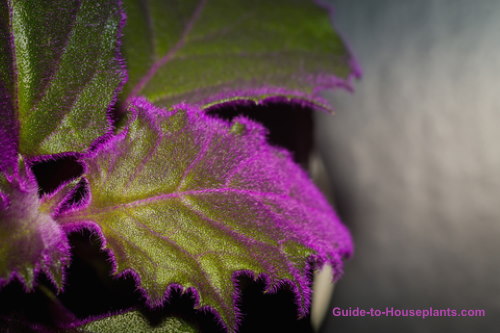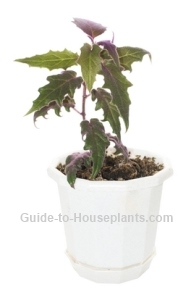Purple Passion Plant Care
Purple passion plant is covered with purple fuzzy leaves that make it a stunning houseplant. Find out how much sunlight and humidity this tropical native wants, when to repot, and why you should pinch your plant.
 Shimmery, velvet leaves make this tropical plant a captivating houseplant.
Shimmery, velvet leaves make this tropical plant a captivating houseplant.Get to Know Your Purple Passion Plant
Known botanically as Gynura aurantiaca, purple passion plant has origins in tropical Indonesia.
How big does it get? Upright forms may reach a height of 2 ft (60 cm) tall. Trailing forms can grow to 4 ft (1.2 m) long.
Purple passion plant is known for its finely serrated green leaves, densely covered with purple hairs. The leaf undersides and stems are also hairy, giving the whole plant an iridescent, velvety sheen.
Do purple passion plants flower? Yes. After they're a year old, they bloom in spring with yellow-orange flowers, about 3/4-inch (2 cm) wide. But you'll want to pinch them off. They're not only ugly, they have a bad odor. You may notice that your plant will begin to decline after flowering. That's why it's a good idea to propagate cuttings to replace your plant. It's fast-growing, so you'll have a big, lush-looking new houseplant in no time.
Shed some light. Providing bright light will enhance the color of this stunning foliage plant. If the leaves are more green than purple, move the plant to a sunnier spot. Keep it out of harsh, direct sunlight, though, because its leaves will scorch.
Pinch it back. Pinching off the stem tips is the way to make it branch out for a fuller, bushier plant. Don't toss out those stem tip cuttings, either. They'll root easily, giving you more beautiful plants.
Water regularly. Purple passion plant is a "fainter" if the soil is allowed to dry out. However, you can revive it quickly with a thorough watering. Aim to keep the soil evenly moist during the growing season, slightly drier in winter.
Green Thumb Tip
Careful with that water! Avoid getting the velvety leaves wet. Drops of water will cause dark spots on the leaves and they won't come off.
If the leaves need to be cleaned, brush them gently with a soft, dry brush, such as a small paintbrush.
Wondering when to repot? Give your houseplant a bigger pot to grow in to every couple years or so. Choose a container 1- to 2-inches larger than the old one. Use one with drainage holes to prevent soggy soil. You'll find the steps to repotting house plants here.
Is purple passion plant pet safe? Yes. According to the ASPCA, it's non-toxic and safe around cats and dogs.
Something bugging your houseplant? Look for aphids along the stems and under the leaves. Aphids attracted to soft, new growth, which this houseplant has in abundance. Isolate any infested houseplant to prevent pests from moving on to your other indoor plants and treat it right away.
Purple Passion Varieties
This popular plant may be labeled by any of these common names: Purple Passion Plant, Purple Passion Vine or Velvet Plant. Some have an upright growing habit, others are vining.
If you're looking for an upright form of Purple Passion, look for Gynura aurantiaca. Want the trailing vine type for a hanging basket? Gynura sarmentosa has twining stems that can be trained to grow up a trellis or left to trail.
Purple Passion Plant Care

Light: Bright indirect light. Some direct morning sun is fine, but avoid strong summer sun which can scorch its leaves.
Water: Keep the soil evenly moist spring through fall. Gynura aurantiaca will wilt when the potting mix dries out. Water less in winter, keeping the plant barely moist. When watering, take care not to get water drops on the leaves which can damage them.
Humidity: This tropical native likes moist air. If the relative humidity drops below 50%, use a pebble tray or cool-mist room humidifier. Don't mist this plant because the hairs trap moisture that may cause the leaves to rot.
Temperature: Average room temperatures 65-75°F/18-24°C.
Soil: Peat moss-based mix, such as African violet potting mix
Fertilizer: Feed every 2 weeks spring through fall with a balanced water-soluble fertilizer diluted by half. Feed monthly in winter when growth is slower.
Propagation: Take 3-4 in (7.5-10 cm) stem tip cuttings in spring or early summer. Cut just below a node -- the place where a leaf is attached to a stem. Dip cut ends in hormone rooting powder and place in moist peat moss or perlite. Enclose in a clear, plastic bag or cloche for the first couple weeks to hold in moisture.


